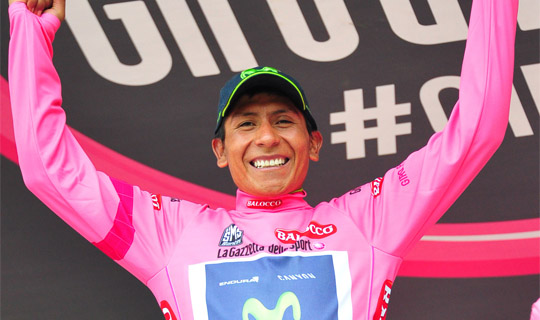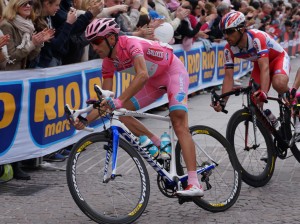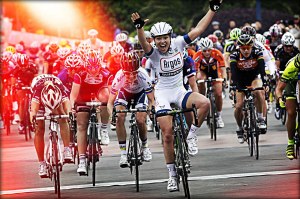Giro d’Italia 2014 week 3 – stages 17 through 21
After the Stelvio ‘controversy’ the peloton awarded itself a fourth rest day on Wednesday’s stage to Vittorio Veneto. As riders placed their feet in bowls of hot water and nursed a Cup a soup overnight a collective hissy fit was aired officially (between the team’s organisation, the UCI and RCS) and unofficially on social media about the legitmacy of Nairo Quintana’s stage win and capture of the race lead from Rigoberto Uran. The likelihood of teams withdrawing enmasse was never that much of a possibility and by the end of the race any lingering indignation looked academic.

From VCSE’s vantage point on the sofa it seems that any suggestion that the race ‘coulda, woulda, shoulda’ be neutralised disappeared when Sky’s Dario Cataldo said ‘no thanks!’ to the offer of an extra layer of clothing and his musette and went charging off on the descent. Yes, riders did stop at the top of the Stelvio, but at random. VCSE didn’t see a single example of an entire group of riders coming to a halt. The apparent ‘smoking gun’ evidence against the Quintana group, that included other GC contenders like Ryder Hesjedal, was the photo of the Columbian descending behind a moto with the pillion holding a red flag. It wasn’t altogether clear what the flag signified but it certainly wasn’t to indicate that the race had been neutralised. Whether it was safe (or not) to continue to race the descent off the Stelvio seems a moot point. Were there any crashes? In the (undoubted) confusion that followed the sum up seems to be those that chose to race, did and anyone else suffered the consequences of that.
The lack of interest shown by the new Maglia Rosa and his GC rivals the following day bore testimony at the difficulty of the previous day however. No one watching, let alone taking part, could deny it hadn’t been a tough stage with the addition of the climb to Val Martello added a 14% insult to the Stelvio / Gavia injury. The peloton crossed the line more than 15 minutes down on eventual stage winner Stefano Pirazzi. Last years KOM winner had been out of contention for that prize since the carnage of the Cassino stage but he salvaged some pride for himself and further built on Bardiani’s success at this years race.
A break of sorts was allowed the win the following day as well as the Giro returned to the mountains for its penultimate summit finish. This years KOM and (yet another) Columbian, Trek’s Julian Arredondo took the stage from compatriot Fabio Duarte reinforcing the thought that the race was rapidly becoming some kind of South American benefit. Quintana arrived with Uran, but it was Cadel Evans who was the biggest loser of the day falling off the podium and almost out of the top ten.
This years edition of the Giro was well and truly back loaded with climbs and if the Stelvio / Gavia double wasn’t enough there was still the Zoncolan to look forward to and possibly shake the GC up further. Ahead of that an uphill TT, 27km in length of which more than two-thirds averaged nearly 8% maxing out at 14%. No TT bikes here then and the climbers and GC boys to the fore. Breakaway fixtures Cataldo and Lotto’s Tim Wellens performed well for their top ten placings but the podium spots went to the GC contenders. Very nearly the ride of the stage went to Fabio Aru, just missing out on the win, but claiming a podium place from Pierre Rolland. The home crowd showed partisan support to a home rider who was now in with the best chance of a repeat Italian victory, but Quintana was the expressionless asassin of local hopes as he put 17 seconds into Aru at the line.
And so to the ‘final’ GC stage; Zoncolan. Actually, the profile shared a reasonable amount with Tuesdays three peak extravaganza adding a cat 1 and 2 climb into the mix ahead of the summit finish. A decent sized break had got away here as well and the finale provided a race within a race as we waited to see who would take the stage and could anyone threaten Quintana’s lead. The latter really wasn’t ever in doubt. While Quintana rode much of the climb unsupported, Uran hasn’t really looked capable of attacking anyone over the three weeks and certainly not since he took the Maglia Rosa. It was an OPQS rider who did the damage to split the final group to pieces, but that was Wout Poels.
Up the road stage 11 breakaway winner was involved in a dual with emerging Bardiani (yes, them again) rider Francesco Bongiorno. In truth, Rogers looked the stronger of the two even if Bongiorno hadn’t lost out when an attempt to ‘help’ him hadn’t backfired and pushed him into Rogers wheel and out of his pedal. If Rogers first win had been unexpected then a second on this stage and this climb was perhaps even more so. Rogers had more help on this one, crucially Tinkoff Saxo had two experienced men in the break, but even so the win wasn’t universally accalaimed.
Five minutes behind and below, while Rogers was helped from his bike by team owner Tinkoff, Quintana was making serene progress up the Zoncolan in attendance with a trio of QPQS outriders. If there wasn’t going to be a fight between the two Columbian’s there wasn’t much of a battle between those riders contending for the final podium place. Aru had already done the damage to Rolland and stealing a few more seconds on the line was just proving a point. You almost hoped for a Hinault, Lemond style Alpe du Huez celebration by Quintana and Uran as the line approached but despite being awarded the same time the wasn’t any overt sign of cameraderie. In the final analysis it was the Zoncolan itself that provided the drama on the day with unruly fans and the riders fighting the climb more than each other.
The final day’s parade into Trieste was always likely to finish in a sprint, although quite a few riders had a stab at winning from a break. At one stage three time stage winner Nacer Bouhanni looked like he would be out of contention, but his stalwart lead out man Sebastien Chavanel managed to pull him back to the front only for Giant’s Luka Mezgec to show once again that the team have depth behind Degenkolb and Kittel.
Giro d’Italia 2014 wrap up
So what does this years Giro tell us about the state of play in 2014 and looking ahead to the rest of this season and the next? Nairo Quintana justified his favourite status and everyone (in particular his rivals) admits he would have won the race without needing any advantage that might have been stolen on the Stelvio stage.
It’s a leap further to suggest, as Movistar have done, that Quintana was right to target the Giro over the Tour following his second place in France last year. Of course, having made the point that Quintana was an unknown quantity going into the Giro and thus wasn’t an automatic favourtite as a result the same could be said of Chris Froome going into this years Tour. If Quintana has been so strong at the end of May it does make you wonder how good he could have been at the start of July. Movistar look like the team best placed to control a race from the front too. Without taking anything away from Quintana’s win it does feel a little like the easier option has been taken in not pitting the Columbian against Froome this year. Of course, the Tour lacks the really steep (in sections) parcours of the Giro but it’s a shame that we will have to most likely wait until 2015 to see a Froome, Quintana match up.
The VCSE view on Rigoberto Uran ahead of the Giro was (to paraphrase Eminem) that the real Uran needed to stand up. Uran had looked second best against established OPQS rider Michael Kwiatowski so far this year and other than the stage win where he took the Maglia Rosa didn’t look as if team leadership sat well on his shoulders. Of course, there’s no shame in finishing on the podium at a grand tour but it does look as if Uran lacks the final few percent that separate the contenders from the champions. The OPQS team selection plays a part too though, lacking enough strong climbers to go with Poels and Pauwels to match up against Movistar and the distractions of the team management making too much of the Stelvio incident.
Perhaps a bigger disappointment, at least for the home fans, was Domenico Pozzovivo. The AG2R rider carried form into the race and at the end of the first week looked like the form rider. He flattered to deceive however and while a top ten was the VCSE prediction ahead of the race, Pozzovivo didn’t fulfil his own prophesy that he would “..attack”. Cadel Evans faded sharply in the final week, his strategy of sticking with the leader during each stage back firing completely on the Stelvio stage as he got caught with Uran as Quintana rode away. Once Quintana had taken the jersey Evans looked less and less likely to not lose time. This is likely to be his last time as a challenger for GC in a grand tour.
Fabio Aru had been touted as a climbing talent ahead of the Giro, but Astana had him in a supporting role to Michele Scarponi who had joined the team to become the number two GC rider behind Vincenzo Nibali. Third place, some strong climbing performances and his win on stage 15 puts Aru into ‘great white hope’ category for Italian GC hopes in the next five years and for now the heir apparent to Nibali. It will be interesting to see now if Astana give Scarponi another shot at a grand tour in this years Vuelta or will Aru be elevated to team leader without having the role handed to him by events. Of course, Aru isn’t the only young Italian rider who has grand tour credentials in the peloton, but he has looked the most convincing this week and everyone will always take notice of an apparent ‘surprise’ emergence, just as they did with a certain Columbian last year.
Nacer Bouhanni’s win of the points jersey is an interesting one. This blog lauded Mark Cavendish’s victory last year as a triumph in a contest that doesn’t tend to favour sprinters. Does Bouhanni’s win put him on a par with Cavendish or was the competition less this year? Certainly, as mentioned in the Giro preview the first rank of sprinters were largely missing (Kittel went home after the Irish stages). If nothing else Bouhanni, out of contract this year, has put himself in the shop window and if he can take Chavanel with him could bring some much needed sprint credentials to somewhere like Sky next year.
Perhaps the happiest team in terms of results would be Bardiani with three stage victories in this years Giro. Bardiani took a stage last year, but the team that featured most at the front of the race was Vini Fantini only for them to fall foul of positive drug tests. There’s been no such suspicion about the Bardiani team this year and with the emergence of riders like Aru it’s to be hoped that scandal doesn’t engulf what could be the start of a brighter era for Italian cycling that isn’t tainted by doping.
This years Giro will be remembered as a Columbian renaissance . Amongst the crashes and manufactured controversy Quintana’s win and strong showing from Columbian riders from teams throughout the peloton (as well as the ‘national’ team) it feels as if naturally talented riders are once again coming to the fore. The most numerous nation represented in the top 30 on GC outside of the hosts, Columbian riders took the KOM (Arredondo) as well as four stage wins (Quintana two, Uran and Arredondo one each). Quintana has made the leap in little over a year from a climber to grand tour winner and is the strongest evidence yet of a cleaner doping free peloton.






